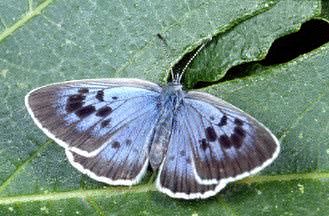- Large Blue (butterfly)
Taxobox
name = Large Blue
status = LR/nt | status_system = IUCN2.3
UK BAP status = Priority Species

image_width = 220px
regnum =Animal ia
phylum =Arthropod a
classis =Insect a
ordo =Lepidoptera
familia =Lycaenidae
subfamilia =Polyommatinae
genus = "Maculinea "
species = "M. arion"
binomial = "Maculinea arion"
binomial_authority = (Linnaeus, 1758)
synonyms = "Glaucopsyche arion"The Large Blue ("Maculinea arion") is a blue
butterfly , that is resident inEurope and some parts ofAsia . The butterfly became extinct in theUnited Kingdom in 1979, but has since been reintroduced by conservationists [ [http://www.telegraph.co.uk/earth/main.jhtml;jsessionid=R2UX23YHVPYZPQFIQMGCFFOAVCBQUIV0?xml=/earth/2007/12/27/eaweather227.xml 2007-record numbers spotted in Somerset] ] UK BAP Status: Priority Species. Uncommon everywhere in the world. The Large Blue primarily resides in heaths, sand dunes and hillsides.Large Blue
caterpillar s are about half an inch in length and can live as long as 9 months before they form a chrysalis to become abutterfly . Large Blue butterflies have a wingspan of up to 2 inches, and will live for only a few weeks. The wings of the Large blue butterfly are speckled with black dots. Compared to a Large Blue caterpillar, the adult's lifespan is short.Large Blue caterpillars feed on wild
Thyme orMarjoram flowers for the first few days of development. Afterwards, they seek out the nests ofMyrmica sabuleti , a specific species of red ant, and hibernate inside their tunnels. On emerging from hibernation, the caterpillars will then begin to eat the red ant's eggs andlarvae for up to 3 weeks. It will then hang itself by its legs on the nest's roof and build a chrysalis around itself. The caterpillar will spend a further 3 weeks transforming into the Large Blue butterfly adult. After its change from caterpillar to butterfly, the insect emerges from its chrysalis and leaves the red ant nest to find a mate. Usually, red ants will escort the newly emerged butterfly to the surface, taking it to a low plant or shrub nearby. The red ants will encircle the butterfly and ward off any predators that attempt to attack the butterfly as it dries out. After the butterfly is ready to fly away, the ants will retreat back into their nest. In addition to Myrmica sabuleti, there have been instances of the butterfly larvae usingMyrmica scabrinodis but with much poorer survival rates. In the UK and in cooler or more mountainous areas in Europe, wildThyme is the foodplant.Marjoram being used by populations in warmer areas.Pregnant Large Blue females will lay their eggs only on wild thyme buds or on the buds of Marjoram, which young caterpillars feed exclusively on until after the third moult, when they are ready to seek out the appropriate ants nest. On sites where Large Blues occur there is usually a high density of appropriate ants nests. When the caterpillar is ready, it will drop itself off the foodplant and wait to be picked up by a passing red ant, which will then carry it to its nest. The red ant strokes the caterpillar with its antenna, making the caterpillar produce a small drop of honeydew. This action is called "milking", which the ant continues to do until the caterpillar raises half of its body into the air. When this happens, the red ant picks the caterpillar up with its jaws and takes it into its nest. Once inside the red ant's nest, the ants will stroke the caterpillars with their antenna. After a while, the Large Blue caterpillar secretes more honeydew on which the red ants and their young feed. Soon after this process is complete, the caterpillar will seek out the nesting chambers and proceed to eat red ant eggs and larvae. When winter draws near, the Large Blue caterpillar begins to hibernate.
Often, the red ant colony will bring in too many Large Blue caterpillars. When this happens, the caterpillars usually eat all the red ant eggs and larvae, thus eliminating the colony. However, with no ant eggs to feed on, the caterpillars starve to death. Another bizarre and unexplainable occurrence is that when the red ant colony produces more than one queen ant, the workers are often sent to attack and eat the caterpillars.
To make itself less of an intruder to the red ants, Large Blue caterpillars will adopt the red ant's scent and mimic the ant's sounds, in addition to providing the ants with honeydew. Once the caterpillar is inside its chrysalis, it will rub its head against the chrysalis walls to make a scraping sound that the red ants make. Failure to complete any of these disguisements will often lead to the caterpillar being eaten by the red ants.
References
*Reader's Digest, "The Wildlife Year", p 190, ISBN 0-276-42012-8.
*IUCN2006|assessors=Gimenez Dixon|year=1996|id=12659|title=Maculinea arion|downloaded=9 May 2006External links
* [http://www.zi.ku.dk/personal/drnash/atta/Pages/LargeBl.html The life cycle of the Large blue butterfly] .
* [http://www.cornwallwildlifetrust.org.uk/nature/inverteb/largeblue.htm Indepth information on the Large blue butterfly] .
* [http://www.butterflyconservation.org/species/large_blue/project.html Butterfly Conservation - Large Blue Project] .
* [http://www.cornwallwildlifetrust.org.uk/nature/inverteb/largeblue.htm Cornwall Wildlife Trust - Large Blue Reintroduction] .
Wikimedia Foundation. 2010.
